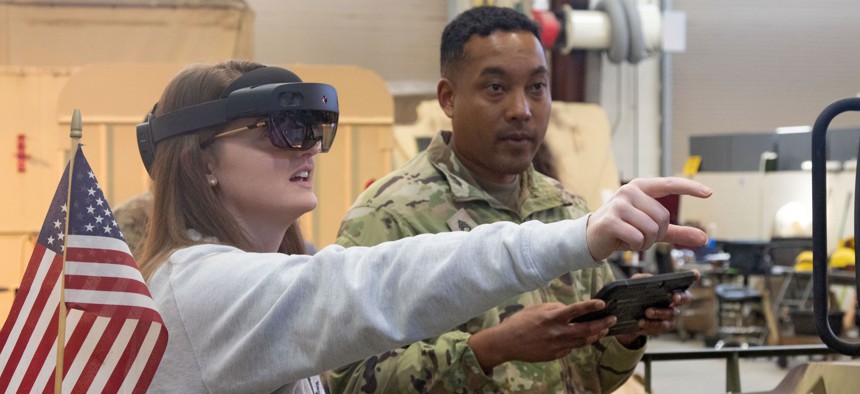How better data can support military training and performance

Soldiers of 188th Infantry Brigade demo an virtual reality system at a recruiting event at Fort Stewart in Georgia on December 1, 2022. DOD photo by Sgt. Darryl Briggs
COMMENTARY | Wearable computers along with AR and VR capabilities can generate data to customize military training to enhance performance and improve the mental and physical health of trainees throughout their service and the rest of their lives.
It stands to reason that physical ability would be at the top of the military training roster. But decades of research on the human mind and body have shown that warfighter training must widen its scope: mental toughness and resilience is just as critical for the average soldier.
A new training paradigm, human performance training, encompasses just that – a way to support physical and cognitive training for service members both during their active-duty tenure and beyond.
Human performance training combines human research with the latest advances in data science: wearable sensors, virtual reality, and augmented reality. Using data-driven methodology, this training model is designed to cater to the unique physiological needs of individuals.
So, what does this look like? Warfighters can take advantage of realistic AR and VR environments, while wearables collect data on their responses to stress. By assessing collected physical factors such as heart-rate variability, current fitness habits, and pain levels, as well as cognitive assessments such as short-term memory, long-term memory and auditory recall, military leaders can get a comprehensive snapshot into their warfighters’ cognitive and physical readiness.
This snapshot, in turn, can be used to develop a holistic, personalized training program to enhance performance, create long-term healthy habits and ultimately improve the overall physical and mental health of trainees throughout their service – and the rest of their lives.
Improving the training and recruitment gap
As it stands, mental and physical fitness are central to the nation’s recruitment gap, with less than a quarter of Americans even qualifying for service. Not to mention, army recruits who make it to basic training are getting injured at an alarming rate, both chipping away at fighter reserves, and costing the government millions of dollars in rehabilitation. But a shift in training can help reduce the number of non-deployable warfighters.
Using human performance data, military leaders can recalibrate training and testing standards to personalize training and reduce the risk of injury. Consider that, in 2022, nearly 30% of female recruits were injured on average each month during Army basic training. Training calibrated to their differences can provide early intervention for these issues and help to retain recruits that may have otherwise been injured or unfit to continue their military occupation.
Accelerating readiness for fighters in the field
For front line fighters, preparation is everything. Recent advances in extended reality, wearables and AI allow the military to “train how you fight.” From actions to reaction time and gaze behavior, these technologies can evaluate fighter performance and deliver feedback similar to in-person instruction. This allows fighters to master their responses and decisions across a range of landscapes and ultimately enhance their skill sets in high-stress situations.
Not only does this provide an opportunity to navigate stressful environments risk-free, test their physical and mental resilience, and monitor their recovery time, but it also prepares warfighters for the most up-to-date scenarios. Simulated environments can be rapidly updated and shared with geographically dispersed teams for highly complex, tactical training.
Supporting veterans post-service
Issues like PTSD and other stressors often follow warfighters into their lives, but the 2022 National Veteran Suicide Prevention Annual Report – looking from 2001 to 2020 – showed an encouraging trend of reduced veteran suicide rates from 2019 to 2020. Continuing this path means further investing in mental health at the time of deployment.
Human performance training is designed to equip warfighters with a greater ability to improve readiness on their own by helping them to recognize personalized signs of potential problems and to develop effective responses to various conditions. Trainees should come out of training with a strong sense of self-awareness and the ability to identify triggers and practice self-regulation techniques that develop into long-term healthy habits and a recognition of personal limitations.
Today’s warfighting landscape is immensely different from a decade ago, and a host of technological innovations have opened the door to boosting soldiers to a new level of physical fitness and mental fortitude. Leaning into this technology and human performance training helps us to stay one step ahead of adversaries.
This training also provides a form of lifelong support from the military: warfighters can maintain ultimate control of their mental and physical wellbeing, optimizing their performance from on the battlefield to life after active duty.



